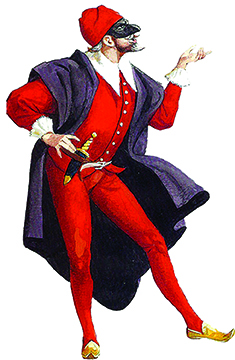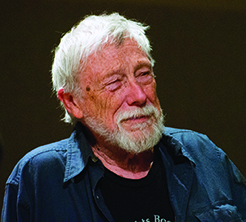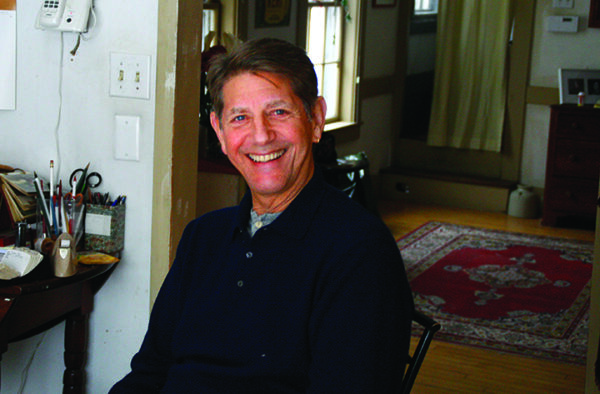In 1955 I was fourteen, and I became fascinated by the rebellious adults of the Beat Generation and their criticisms of American culture. Hearing adults express and clarify feelings I was experiencing as a teenager—the political repression of the McCarthy period (which affected my family personally) and the culture’s fascination with materialism, its racism, and its obviously biased economic and judicial systems—spurred me to read and study Beat authors and poets such as Jack Kerouac, Allen Ginsberg, Gary Snyder, Lew Welch, Philip Whalen, and others. Their interest in Zen led me to a book, The Three Pillars of Zen by Philip Kapleau, which offered me a thrilling (though perhaps romanticized) introduction to Zen and enlightenment. This book planted a hardy evergreen in the soil of my imagination.
Zen is the Japanese translation of the Chinese word chan, which means “meditation.” Zen differs from other schools of Buddhism by being, in the words of Zen master Norman Fischer, who many years later became a role model and friend:
A pithy, stripped-down, determined, uncompromising, cut-to-the-chase, meditation-based Buddhism that takes no interest in doctrinal refinements. Not relying on scripture, doctrine or ritual, Zen is verified by personal experience and is passed on from master to disciple, hand to hand, ineffably, through hard, intimate training.1
This seemed perfect for me, but what did I know? The Beats dug it, and they were cool and adult. That was sufficient pedigree.
Introduced to the concept of enlightenment, I began to see it as the light at the end of the tunnel of my adolescence—a heady possibility to a sexually obsessed teenage boy, clad in baby fat, lousy at sports, afraid of his father, and tongue-tied around girls. Enlightenment would be the key to unlock every mystery, make me immune to the ridicule of classmates, and free me to understand the undecipherable utterances of the Zen masters I encountered in my reading. An instance:
Tanzan and Ekido were once traveling together down a muddy road. A heavy rain was still falling. Coming around a bend, they met a lovely girl in a silk kimono and sash, unable to cross the flooded intersection.
“Come on, girl,” said Tanzan at once. Lifting her in his arms, he carried her over the mud. Ekido did not speak again until that night when they reached a lodging temple. Then he could no longer restrain himself.
“We monks don’t go near females,” he told Tanzan, “especially not young and lovely ones like that girl back there. It is dangerous. Why did you do that?”
“I left the girl back there,” said Tanzan. “Why are you still carrying her?”
I began to read everything I could on the subject and was soon anesthetizing my playmates with facile explanations of Buddhist philosophy, quoting Zen maxims as if I understood them, and imagining myself a hair’s breath away from “highest, perfect, enlightenment,” without ever having met a Buddhist. I was matriculating in my own unaccredited university as a poseur.
After college, I moved to San Francisco to pursue a master’s
degree in creative writing, studying with a poet I admired named Robert Duncan. However, graduate school paled next to the allure of the emerging counterculture, and after my first term and a tepid season with a local theater whose cream of management and talent had been siphoned off to New York to found Lincoln Center, I auditioned and was accepted in a radical street theater company named the San Francisco Mime Troupe.
Mime is not to be confused with pantomime, which, as exemplified by Marcel Marceau and numerous whiteface street performers, creates the illusion of objects in space. Mime as taught by Étienne Decroux, the teacher of the troupe’s founder, R. G. Davis, uses objects to express ideas: an umbrella might become a rifle, a pool cue, or a broom, and a mime troupe very definitely uses speech to convey issues and ideas.
The troupe’s vision was to employ theater, particularly comedy, to further progressive political goals. We performed in the city’s parks, bringing our theater to the people in the tradition of seventeenth-century Italian commedia dell’arte (think human Punch and Judy). Our improvised, bawdy tomfoolery skewered officials, the pompous, and the rich and famous (as the original commedias did). We were enthusiastically appreciated and supported by our audiences, who dropped money in the hats we passed around after performances.
The troupe used traditional Italian masked characters—Pantalone (the miser), Dottore (the know-it-all blowhard), Harlequino (the amorous clown), and the unmasked, clever, not-so-innocent maidservant—comic archetypes that have survived the centuries. We repurposed them to address contemporary events.
Our plays featured flirtatious women, risqué décolletage, pratfalls, double entendres, and lovers fleeing through bedroom windows as husbands entered through doors. The action and dialogue were punctuated by abundant physical play known as lazzi (lahd-zee)—short, very precise bits of comic business that required precise skill and perfect timing. Over and above our success, adventures, and rising celebrity status, as the troupe’s reputation grew, the most startling and enduring experience, one that changed me profoundly, was my introduction to masks.
Ten years before I began my formal study of Buddhism, the day I first performed in a mask, ignited a flame that never lost its heat and glow. Fifty-two years later, I can vividly recall the moment I became Pantalone, my favorite character to this day. I was costumed in his long robes and a codpiece over a red union suit. When I put on the mask, the little goatee of braided rope, and his cap and assumed his traditional hunched-over posture before a mirror, he clicked into holographic focus in my imagination. What a surprise! He spoke the Yiddish-inflected English of my grandfather.
He was cranky, rude, blustering, blasphemous, sly, treacherous, and wicked, and I loved him at first encounter. All the attributes I had scrubbed from my personality, trying to become a mature and good person, were obliterated by Pantalone’s raw vitality, blunt desires, and boundary-less amorality.

Pantalone in a nineteenth-century print, artist unknown
The first time Pantalone introduced his whiny, indulged daughter to the audience, an improvised line whizzed from Pantalone’s psyche straight out through my mouth: “De reason I luv my dawta [a pause and, then, with glee] is dat she killed my vife in childboith.”
Tasteless and inappropriate, I know, but when hurled from the safe venue of a stage, the audience howled with delight—and I had somehow “known” they would before I’d uttered a word.
Behind that mask, I could do no wrong. My familiar self was no longer hovering over my shoulder, criticizing and editing my behavior, insisting on accepting social norms, insisting that I be good, kind, and considerate. Whenever I donned Pantalone’s mask, Peter Cohon (my born name) vanished from my inner landscape. My good manners, sensitivity, and anxieties about what people would think dissipated like steam. What remained was Pantalone—a living, feral id, operating without regard to correctness, social convention, limits, self-judgment, or fear. I had never before experienced such unconstrained freedom, and it became an immediate addiction.
Whenever I encountered an onstage (and sometimes offstage) situation that made Peter “the actor” uncomfortable, it was clear to me that my housebroken self had regained control. I learned to dive into those discomfort zones, refusing to shy away from them, and, little by little, developed the courage to allow Pantalone access to the widest spectrum of impulses and images passing through my spinal telephone. It was a practice I’d developed during numerous psychedelic experiences where, on the verge of some emotional or mental difficulty, I strived to consciously face the fear or discomfort and enjoy it. In every case, the event mutated into something pleasurable.
There is energy in fear and discomfort if you can remain steadfast when it seizes you. Colonized by Pantalone’s spirit, I was no longer the known quantity of Robert Peter Cohon, a middle-class Jewish boy from Englewood, New Jersey. His values (and my parents’ values and judgments) no longer applied in the magical, boundary-less kingdom ruled by Pantalone.
Freedom from fear allowed me to make startling choices onstage and surprising pivots, unencumbered by doubt. Relieved of my own personality, I could do anything in my mask, and it was enthralling fun! Acting behind the mask was not a delusional trance. It was still necessary to remain fully alert to the script, the other actors, and offstage accidents, which it was my duty to acknowledge and fold into the play. All that was missing was my old familiar self. It is the purpose of this book and the classes from which this method arose to offer others this same freedom and explain and solidify with explanations and practices I have learned in my forty-five-year study of Zen….
I eventually left the mime troupe with a number of my colleagues to dedicate ourselves more fully to revolutionary cultural change. We formed a group called the Diggers, imagining a world we would like to live in and actualizing it by acting it out. We fed four hundred to six hundred people a day for free in Golden Gate Park during the -blossoming of the Haight-Ashbury district in San Francisco, established the first free medical clinic with weekly visits by doctors in our Free Store, which offered clothing, furniture, tools, televisions, bicycles, and whatever to the public for free. The unstated question behind the Free Store was: “Why become an employee so that you can become a consumer? We’ll give you the stuff for free. Now, what do you want to do?” We used theatrical devices and improvisatory skills to create institutions we felt would allow people alternatives to having to be employees and consumers.2
During that decade, I had the good fortune to meet and become friends with Gary Snyder, one of the Beat poets I’d been reading in my teens. Gary was already famous by then, a “first among equals” among the Beats, distinguished not only by his talent as a world-class poet-scholar but also as an environmental thinker and essayist. Gary had just returned to California after spending nine years practicing in a Zen monastery in Japan as an assistant to the head teacher. He spoke and wrote Japanese fluently and had married a Japanese woman. If anyone knew what Zen was about, I thought, it would be him.
Our first meeting, arranged by a mutual friend, was disappointing to me because Gary somehow overlooked the fact that I was an enlightened Zen peer. He appeared relatively uninterested in any of my radical politics and scrutinized me calmly, with a directness and depth I found disconcerting. The memory of my uneasiness needled me to meet him again and perhaps observe more carefully how a “Zen guy” lived.
Eventually, a friendship developed between us that included wide-ranging conversations where a single question of mine might provoke an erudite response crossing continents and centuries. Afternoons were consumed in this way. I was way out of my depth in his company, but over the thud of axes and the gravelly plaints of our chain saws, I persisted, while we trimmed trees and brush on Gary’s land in the foothills of the Sierra Mountains.

Over time I came to understand that Gary’s breadth of knowledge was not only vast and scholarly but also impeccably organized. He could speak at length on subjects as diverse as free rock climbing, Native American cultures and beliefs of widely different Native nations, Buddhism as expressed across multiple cultures, Asian art, geology, logging, carpentry, mountain climbing, and in-depth cultural and political appraisals of many lands. He had, upon his return from Japan, enlisted a crew, with friends of mine among them, who, under his instruction, built a wonderful log home—an architectural cross between a Japanese farmhouse and a Native American longhouse constructed of timber grown on his land.3
It required some years before I was able to pinpoint the most compelling and elusive quality of Gary’s personality: he was the first person I had ever met who appeared to be evenly developed across every dimension of his life. I resolved to learn something about that.

About ten years after I met Gary, I courted and later married a woman who was practicing at the San Francisco Zen Center. Though I had been reading about Zen since my early teens, I had no idea what degree of attention and diligence was required to meditate in a traditional Zen practice situation. Under my girlfriend’s influence, I began “sitting” regularly and realized immediately (and painfully) that my ideas about Buddhism had missed not just the mark but the entire target.
It required less than a month of tearing myself out of bed at 5:30 a.m. to be on my cushion in the zendo, the room where zazen, or sitting meditation, is practiced, before the bells chimed. It was humiliating to discover that I was unable to meditate without fidgeting and could not seem to locate the correct place in the morning chant book before the chant had ended and a new one had begun, which I also could not locate. I could not seem to remember to bow to others (whether or not I liked them), nor could I refrain from inserting myself in conversations before my opinion had been solicited. I continually stumbled over subtle details of mindful practice, like entering a room by stepping through doorways with the foot closest to the hinge first. The daily humiliation of repetitive, public errors bludgeoned me with embarrassment until I was forced to admit how callow my ideas about Zen were.
I was saved from fleeing the monastery by a mélange of pride, fear of failure, competitiveness, and deep curiosity. That combo impelled me to keep struggling until somehow I discovered myself in the stream, which is accepting my life as it actually is, a practice I have followed to this day. I am not the man I imagined I might be but perhaps am closer to the man I actually wanted to be even though my current identity resists definition. The truth is I no longer have much of an idea of who I am and remain consistently grateful for that. “Not knowing” and the consequent surprise of discovering every day, moment by moment, who it is that arises now is like a return to a long-forgotten innocence. ◆
1 Norman Fischer, “Nothing Holy,” Shambhala Sun, March 2004.
2 I chronicle this period in my first book: Peter Coyote, Sleeping Where I Fall: A Chronicle, 3rd ed, (Berkeley, Calif.: Counterpoint Press, 2015; first published 1998).
3 There’s an extensive discussion of this house in Coyote, Sleeping Where I Fall.
The Lone Ranger and Tonto Meet Buddha by Peter Coyote © 2021 Inner Traditions. Printed with permission from the publisher Inner Traditions International. www.InnerTraditions.com
This essay appears in our Spring 2022 issue, “Wonder”. Purchase the issue here.
